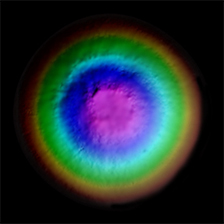Venus Magellan Global C3-MDIR Mosaic 2025m
- Originators
- PDS Geosciences Node
- Publisher
- USGS Astrogeology Science Center
- Abstract
- Product Information: This mosaic was created from the Magellan Full resolution Basic Image Data Records (F-BIDRs), the highest resolution radar images of the Venus surface (~75 meters per pixel [m]). To make this product, the F-BIDR is assembled into Full-Resolution Mosaicked Image Data Records (F-MIDRs) which are then averaged in successive operations resulting in each pixel being the average of nine pixels resulting in compressed BIDR or C-BIDR. The resulting C-BIDR are then mosaicked into 8192 x 8192 arrays called C1-MIDR (Compressed Once - Mosaicked Image Data Record) which are then further compressed into C2- and C3-MIDR. The original Magellan Compressed Mosaicked Image Data Record (C3-MIDR) archive contains three times compressed mosaics of image swaths (C-BIDRs) at a resolution of 2025 m/pixel. C3-MIDRs consist of mosaics generated by computing 3x3 pixel arithmetic moving averages from the C2-MIDRs. C3-MIDRs, with their 2.025 km pixel widths, are designed to cover the planet at reasonably high resolution and high signal to noise ratio. (Ford et al., 1993). Mission and Instrument Information: The Magellan Mission to Venus launched on May 4, 1989 on board the Space Shuttle Atlantis. The spacecraft arrived at Venus on August 10th, 1990 and was inserted into a near-polar elliptical orbit. The primary mission requirements were to map at least 70% of the surface at a resolution better than 300 meters/pixel and to determine the global relief at such a resolution as to facilitate detailed analysis of tectonic, volcanic, eolian, and impact features. Magellan successfully completed four mapping cycles at Venus. The first mapping cycle lasted from mid-September 1990 to mid-May 1991 focused on fulfilling the primary mission requirements. The second mapping cycle was from mid-May 1991 to mid-January 1992 and was dedicated to filing in gaps in the cycle 1 coverage and obtaining coverage of the south polar region; this cycle resulted in 54% of surfaced coverage and increased the cumulative coverage of the mission to 96%. Cycle 3 was from mid-January to mid-September 1992 and focused on acquiring stereo image coverage; this cycle resulted in about 21% surface coverage and increased total surface coverage to 98%. Cycle 4 was dedicated to gravity observations and as such did not add to the cumulative coverage of imagery taken by the spacecraft (Ford et al., 1993). References: Ford, J. P., Plaut, J. J., Weitz, C. M., Farr, T. G., Senske, D. A., Stofan, E. R., Michaels, G., & Parker, T. J. (1993). Guide to Magellan Image Interpretation. JPL Publication 93-24 pp. 1-18. https://ntrs.nasa.gov/archive/nasa/casi.ntrs.nasa.gov/19940013181.pdf Ford, J. P., Blom, R. G., Crisp, J. A., Elachi, C., Farr, T. G., Saunders, R. S., Theilig, E. E., et al. (1989). Spaceborne Radar Observations, a guide for Magellan radar-image analysis. JPL Publication 89-41. https://ntrs.nasa.gov/archive/nasa/casi.ntrs.nasa.gov/19900013510.pdf
- Purpose
- mosaic of the C3-MIDR tiles
Contact and Distribution
- Format
- Global Mosaic
- Access Constraints
- public domain
- Access Scope
- PDS
- Use Constraints
- None
- Edition
- 1
- Supplemental Information
- http://pds.nasa.gov/ds-view/pds/viewProfile.jsp?dsid=MGN-V-RDRS-5-MIDR-C3-V1.0, http://geo.pds.nasa.gov/missions/magellan/c123midr, http://www2.jpl.nasa.gov/magellan/, https://pds-imaging.jpl.nasa.gov/software/MGN_SAR_UserGuide.pdf
- Native Data Set Environment
- ISIS v3
- Astrogeology Theme
- Image Processing, Remote Sensing
- Mission Names
- Magellan
- Instrument Names
- SAR
- Online Package Link
- https://astrogeology.usgs.gov/search/map/venus_magellan_global_c3_mdir_mosaic_2025m
- External File Size
- 170 MB
- Online File Link
- https://planetarymaps.usgs.gov/mosaic/Venus_Magellan_C3-MDIR_Global_Mosaic_2025m.tif
- Contact Address
- 2255 N. Gemini Drive
- Contact City
- Flagstaff
- Contact State
- AZ
- Contact Postal Code
- 86001
- Contact Email
- astroweb@usgs.gov
Data Status and Quality
- Time Period of Content (start)
- 1989-05-04
- Time Period of Content (stop)
- 1994-10-12
- Currentness Reference
- Publication date
- Progress
- Complete
- Update Frequency
- None planned
- Logical Consistency
- Finally, in some cases a cross track seam removal process has been applied.
- Process Description
- This archive was produced by Jason Hyon. Mike Martin (JPL), Gail Woodward (JPL), Peter Ford (MIT), Robert Mehlman (UCLA), and Jason Hyon (JPL) designed the PDS labels and the tables. Florence Moss (JPL) and Jason Hyon developed the software to generate the PDS labels and tables. Raymond Arvidson and Gail Woodward created the catalog templates, with help from Pam Woncik (JPL), Mary Dale-Bannister (Washington University), and Susan Slavney (Washington University). The data and documentation were generated at MIT by Peter Ford, Gordon Pettengill, Fang Liu, and Joan Quigley from data supplied by the Magellan Project. Please direct any questions and comments to the PDS Geosciences Node, geosci@wunder.wustl.edu.
Lineage
- Process Date
- 2022-09-01
- Source Title
- Magellan Compressed Mosaicked Image Data Record (C1-, C2-, C3-MIDR)
- Source Online Linkage
- {https://pds-imaging.jpl.nasa.gov/volumes/magellan.html#mgnMIDR,http://pds-imaging.jpl.nasa.gov/portal/magellan_mission.html}
- PDS Status
- PDS 3 Archived
Geospatial Information
- Target
- Venus
- Minimum Latitude
- -90
- Maximum Latitude
- 90
- Minimum Longitude
- -180
- Maximum Longitude
- 180
- Direct Spatial Reference Method
- Raster
- Object Type
- Grid Cell
- Raster Row Count (lines)
- 9388
- Raster Column Count (samples)
- 18775
- Bit Type (8, 16, 32)
- 8
- Quad Name
- Radius A
- 6051000
- Radius C
- 6051000
- Bands
- 1
- Pixel Resolution (meters/pixel)
- 2025
- Scale (pixels/degree)
- 52.153
- Map Projection Name
- Equirectangular
- Latitude Type
- Planetocentric
- Longitude Direction
- Positive East
- Longitude Domain
- -180 to 180




















